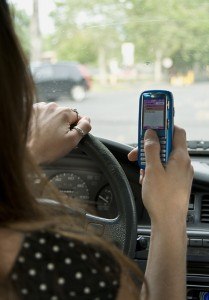 New findings from a Texas study show texting while driving is more dangerous than previously thought.
New findings from a Texas study show texting while driving is more dangerous than previously thought.
Reading or writing a text message behind the wheel can more than double a driver’s reaction time, according to a study released Wednesday by the Texas Transportation Institute.
“Our findings suggest that response times are even slower than what we originally thought,” said Christine Yager, a TTI researcher, who managed the study. “Texting while driving basically doubles a driver’s reaction time and makes the driver less able to respond to sudden roadway dangers, if a vehicle were to make a sudden stop in front of them or if a child was to run across the road.”
Reaction times slowed from one to two seconds with no texting activity, to three to four seconds while texting, the study found. The study found very little difference in response times between a driver composing a message and reading one.
Researchers studied 42 drivers between the ages of 16 and 54 on a test-track driving course in vehicles equipped with a flashing light and a monitoring system. To put the findings in context, Yager said drivers going 30 mph travel 220 feet in five seconds. At 60 mph, a driver covers 440 feet in five seconds, she said.
“If you’re on a freeway where the speed limit is 60 in rush hour and a vehicle suddenly stops in front of you, that’s not enough time to react if your eyes are glanced down at your phone,” Yager said.
Drivers in the study were more than 11 times more likely to miss the flashing light altogether when they were texting.
Researchers say the study is the first published work in the U.S. to examine texting while driving in actual vehicles rather than in simulators. Studies have been confined to simulators in the past for safety concerns. The researchers said 40 drivers is considered by the research community to be an acceptable number to produce meaningful findings in this type of study; other similar studies quoted by the report used as few as 20 drivers.
Texting and driving has already been deemed dangerous, with 34 states adopting texting and driving bans, according to the Governors Highway Safety Association. The Texas Legislature approved a texting ban earlier this year, but Gov. Rick Perry vetoed the measure, calling it an “overreach” and a “government effort to micromanage the behavior of adults.” Texas law does ban cellphone use in school zones and includes restrictions for drivers under the age of 18.
In 2009, nearly 5,500 people died and half a million were injured in crashes involving a distracted driver, according to figures from the National Highway Traffic Safety Administration. Distraction-related fatalities represented 16 percent of overall traffic fatalities in 2009, the agency said. It’s unclear how many of those fatalities can be blamed specifically on texting.
“If you look down to text for just a few seconds at 55 miles per hour, your car travels the length of a football field while you’re not looking at the road,” U.S. Transportation Secretary Ray LaHood said in a statement responding to the study. “Texting and talking on the phone while driving can be deadly, and drivers have a responsibility to put away these distracting devices every time they get behind the wheel.”
To conduct the study, researchers monitored participants on a closed driving course three times: without sending or receiving text messages, while continuously composing a story of their choice and while continuously reading a fairy tale sent to their mobile device.
Participants, who were paid $40, were recruited through word of mouth and from a database of past research participants. About two-thirds of the participants, using their own mobile devices, used touch-screen phones, while the rest used a raised QWERTY keypad. Gender was approximately split.
Yager said the institute, which is part of Texas A&M University, doesn’t take positions on what laws should be adopted. The goal is “to provide objective research findings that we hope would be helpful to people in the public policy arena so they can make informed decisions,” she said.
The study also found texting impaired the ability of drivers to maintain proper lane position and a constant speed.
Jonathan Adkins, a spokesman for the Governors Highway Safety Association, said the study bolsters the group’s push for a texting ban in every state.
“Texting while driving is dangerous and drivers really don’t have any business texting while driving, no text is that important,” Adkins said.
Adkins said most drivers overestimate their ability to multitask while on the road.
The TTI study “gives more and more credibility to the fact that texting while driving is dangerous.
“Maybe it’ll have some impact in Texas as well, maybe it’s the tipping point. We can hope at least.”
Was this article valuable?
Here are more articles you may enjoy.

 Singer’s Elliott Sued by PE Firm in Escalating Fight Over Money
Singer’s Elliott Sued by PE Firm in Escalating Fight Over Money  California Governor Seeks $200M to Replace EV Tax Credits Cut by Trump
California Governor Seeks $200M to Replace EV Tax Credits Cut by Trump  JPMorgan Wins Gender Pay Gap Dispute Against London Analyst
JPMorgan Wins Gender Pay Gap Dispute Against London Analyst  OpenAI And Microsoft Sued Over Murder-Suicide Blamed on ChatGPT
OpenAI And Microsoft Sued Over Murder-Suicide Blamed on ChatGPT 